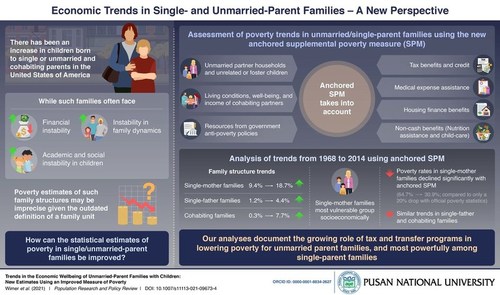BUSAN, South Korea, Nov. 3, 2021 /PRNewswire/ — The traditional definition of a family that included a married couple with children has undergone a gradual divergence over time. Over the last few decades, there has been an increase in the number of children born to unmarried parents, either single or living together, in the United States (US).
Evidence suggests that such children face increased risks of academic and social instability, and their families may be more financially unstable than married parent families. Moreover, official statistics indicate higher poverty rates of unmarried single or cohabiting parent families than those of married parent households. But with the outdated definition of a family unit, do these estimates truly reflect the socio-economic trends of new-age families?
Now, in a collaborative study between Pusan National University, South Korea, and Columbia University, USA, researchers have re-analyzed poverty estimates in unmarried parent families using an all-new holistic approach–the "Supplemental Poverty Measure (SPM)"–that accounts for criteria specific to such family structures. "The SPM better allows us to distinguish the role of government policies and programs in reducing poverty and examine how they influence improvements in future outcomes such as education, health, and income", explain Professor Jaehyun Nam, from Pusan National University, and his colleagues at Columbia University, published in Population Research and Policy Review. This paper was made available online on 9 August 2021 and was published in the journal on 16 September 2021.
The researchers analyzed SPM data from 1968 to 2014 from the Current Population Survey’s Annual Social and Economic Supplement and the Consumer Expenditure Survey. They then developed an anchored SPM model that adjusts poverty thresholds according to the changing standards of living. The SPM accounts for the incomes, shared resources, and living conditions of cohabiting couples, and includes adopted or foster children living with unmarried couples. Moreover, this approach takes into consideration government anti-poverty policies, tax credits, in-kind benefits such as supplemental nutrition for women and children, medical and healthcare incentives, and housing financial assistance.
The analysis revealed an increase in single-mother families, single-father families, and cohabiting families across the years from 1968 to 2014; with single-mother families being the most economically vulnerable. Interestingly, under the SPM, the initial poverty rate for single-mother families of 64.7% dropped to 30.9% over time, as opposed to only a 20% drop noted using official statistics alone. Similar trends were observed across single-father and cohabiting-parent families. These findings suggest that inclusion of tax and cash or kind benefits substantially lowers the otherwise overestimated poverty rate in unmarried-parent families.
"The evidence from this study sheds light on the role of the safety net in improving the economic wellbeing of low-income unmarried-parent families that face a higher risk of poverty," Professor Jaehyun Nam and his colleagues at Columbia University conclude.
Reference
Title of original paper: Trends in the Economic Wellbeing of Unmarried-Parent Families with Children: New Estimates Using an Improved Measure of Poverty
Journal: Population Research and Policy Review
DOI: https://doi.org/10.1007/s11113-021-09673-4
Corresponding author’s name: Jaehyun Nam
Corresponding author’s email:
322844@email4pr.com
ORCID ID: 0000-0001-8834-2627
About Pusan National University
Website: https://www.pusan.ac.kr/eng/Main.do
SOURCE Pusan National University


